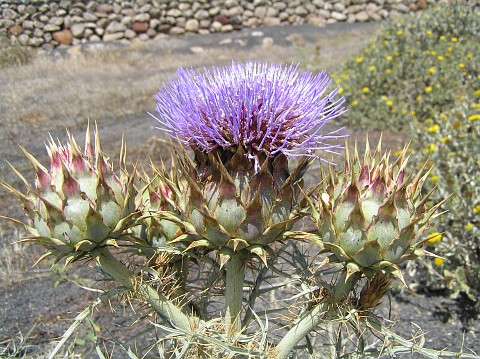
The culture has cardoon
Cardoon (Cynara cardunculus L) is a perennial plant native to the Mediterranean. It belongs to the botanical family Compositae (or Asteraceae). The consumed part is the stalk, also called coast (young and tender). The vegetable diet is nutritious and it is rich in vitamins, Ca, potassium and sodium. In Morocco, the main production regions are Rabat, Casa, Sais and Marrakech.
Pedoclimatic preferences:
The plant is cold season with demanding soil moisture. Seeds do not germinate below 10 ° C (soil temperature optimum: 12- 15 ° C). The optimum for the growth of 20- 22 ° C. Requirements are low soil; Culture prefers deep soil, medium texture. Land sand-clay, not too moist, well-draining, are suitable for cultivation. The optimum pH of the soil is of 6 to 6.8.
Varieties, tillage and seeding:
The main varieties used in Morocco are enhanced Blanc, full unarmed, the dwarf thistle Italy. The spread is sexual. The number of seeds per gram of seed is 20-25. The nursery is commonly used in the USA. In Morocco, the multiplication is done exclusively by direct seeding definitive establishment. The sowing date for a spring crop is from March to April (dates tailored for Tadla). Germination is slow, it is recommended to soak the seeds in warm water overnight before planting; it must be quickly performed the next day.
The arrangement of plants in the field is 1- 1.2 m between ridges x 70 cm planting holes between 3-4 seeds in the row. The need for seed is 1.5-2 kg / ha. It performs a thinning at the 2-3 leaf stage, leaving only a well-developed plant per hill. Planting density (after thinning) is 12,000 to 15,000 plants / ha.
It is also possible to multiply the cardon asexually, by bursts of strains or axillary buds collected from feet of one year.
Irrigation:
Water needs are high during the growing and harvest approaches. We must maintain a constant moisture in the soil with moderate irrigation. Two to three hoeing-weeding are necessary as well as regular watering along the crop cycle. Water supplies are of the order of 450-500 mm / crop cycle of 5-7 months.
Fertilization:
The basal dressing consists of 50 t / ha manure + 40 kg N + 40 kg + 100 kg P2O5 K2O / ha. This coverage includes 50 kg N + 10 kg + 60 kg P2O5 K2O / ha per intake. x 4 inputs. Stages fertilizer application are second to third leaf stage 20 days later, a month later then a month later. The culture is also challenging Sulphur and Magnesium. An intake of 50- 100 kg of S and 20- 40 kg Mg / ha often prove necessary.
Main enemies of culture and Controls:
The main enemies of culture are weeds (we can apply a pre-emergent herbicide), insects (cutworms, wireworms and aphids), diseases (mildew, pithium, Rhizoctonia). You have to respect crop rotation (no cardoon or artichoke after composacée).
Harvesting and product handling:
The harvest begins at the stage of full development that must be fleshy petioles and tender. Harvesting should be daily to pass part of the production without flooding the market whose absorption capacity is generally low, otherwise prices collapse. The harvest starts 5-7 months after sowing. The peripheral leaves are removed and a part of the rhizome is cleaned. The middle leaves are sliced ¾ of their length. Cardoon is sold at the clump of one or two feet according to their force. Sometimes the tuft is tightened, bound and covered tar paper to whiten and reduce its chlorophyll (Europeans prefer a bleached cardoon). The national average yield is 20-25 t / ha.
Terms of good conservation:
For storage a few days, the best storage conditions are: 7- 10 ° C and 90-95% RH. It is best to soak the rhizome and the basal part of the leaves in cool water and change the water twice a day. Never keep the chard in the refrigerator; it quickly loses its quality and becomes tender vegetable filamentous and undesirable texture. The vegetables must be sold as quickly as possible without conservation. The local conservation should be well ventilated.
Agronomic and Veterinary Institute Hassan II
Aucun commentaire:
Enregistrer un commentaire